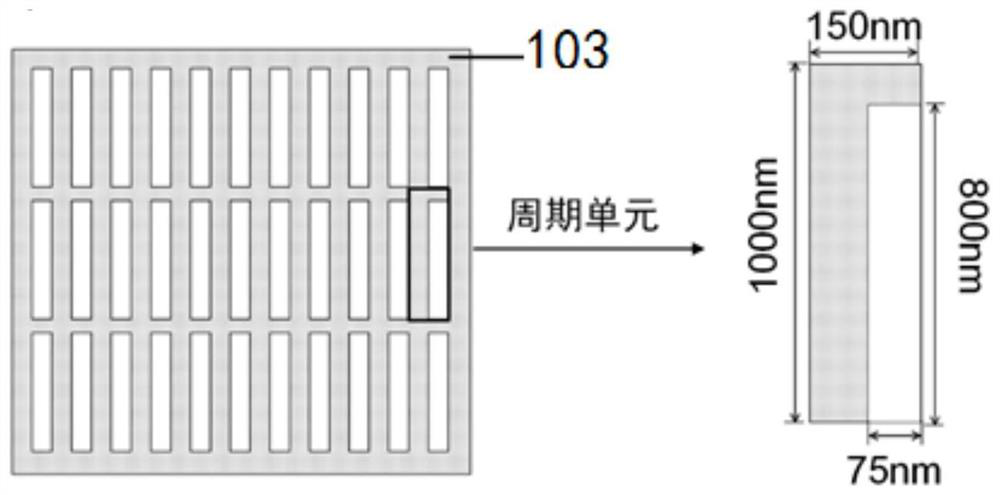Graphene surface plasmon devices, surface plasmon waveguides and optoelectronic devices
A graphene surface and plasmon excitation technology, applied in the field of infrared light detection, can solve problems such as dynamic regulation of graphene plasmons that have not been mentioned
- Summary
- Abstract
- Description
- Claims
- Application Information
AI Technical Summary
Problems solved by technology
Method used
Image
Examples
Embodiment 1
[0036] see figure 1 , is a schematic structural diagram of an embodiment of a graphene surface plasmon waveguide of the present invention. Specifically, the graphene surface plasmon waveguide of this embodiment includes conductive A capacitor-like structure composed of a periodic scatterer 103, a dielectric layer 102 and a graphene layer 101, wherein,
[0037] The graphene layer 101 is a single layer or two layers of continuous graphene without nano-patterning, with a size of 100 μm×100 μm (of course, the size of the graphene layer can be adjusted according to the actual size of the waveguide);
[0038] The dielectric layer 102 is made of aluminum oxide with a thickness of 5nm; the conductive periodic scatterer 103 is made of two-dimensional conductive grating layer and made of 80nm thick gold; specifically, see figure 2 , the two-dimensional conductive grating 103 is composed of periodic rectangular holes with a period of 1000nm×150nm, wherein the size of the rectangular ho...
Embodiment 2
[0043] The present invention also provides another graphene surface plasmon waveguide, the structure of which is the same as that of the above-mentioned embodiment, both including a conducting conductive periodic scatterer 103 and a graphene layer 101, and a conductive periodic scattering The dielectric layer 102 between the body 103 and the graphene layer 101, the difference is that in this embodiment,
[0044] The graphene layer 101 is three-layer / fifteen-layer graphene, and each layer is continuous graphene without nano-patterning;
[0045] The dielectric layer 102 is made of multilayer two-dimensional boron nitride with a thickness of 15nm;
[0046] The conductive periodic scatterer 103 adopts a two-dimensional conductive grating layer, which is made of indium tin oxide with a thickness of 300nm, and the first period is 250nm, the period unit is a square hole, and the side length of the hole is 70nm, see image 3 .
[0047] Of course, in this embodiment, the periodic uni...
Embodiment 3
[0049] The present invention also provides a graphene surface plasmon waveguide, which includes the structure of the above-mentioned embodiment 1 or embodiment 2, the difference is, see Figure 5 , The graphene surface plasmon waveguide in this embodiment also includes a reflection enhancement layer 104 located below the conductive periodic scatterer, specifically, the reflection enhancement layer 104 sequentially includes from top to bottom:
[0050] A cavity length control layer 1041 made of potassium bromide with a thickness of 1.5 μm; and a reflective layer 1042 made of silver with a thickness of 100 nm.
[0051] In this embodiment, a resonant cavity is formed by the cavity length control layer and the reflection layer, that is, the reflection enhancement layer.
[0052] Further, in order to enhance the adhesion between the reflective layer 1042 and the substrate in the optoelectronic device, titanium with a thickness of 5 nm is disposed under the reflective layer 1042 to ...
PUM
| Property | Measurement | Unit |
|---|---|---|
| thickness | aaaaa | aaaaa |
| thickness | aaaaa | aaaaa |
| thickness | aaaaa | aaaaa |
Abstract
Description
Claims
Application Information
 Login to View More
Login to View More - R&D
- Intellectual Property
- Life Sciences
- Materials
- Tech Scout
- Unparalleled Data Quality
- Higher Quality Content
- 60% Fewer Hallucinations
Browse by: Latest US Patents, China's latest patents, Technical Efficacy Thesaurus, Application Domain, Technology Topic, Popular Technical Reports.
© 2025 PatSnap. All rights reserved.Legal|Privacy policy|Modern Slavery Act Transparency Statement|Sitemap|About US| Contact US: help@patsnap.com



